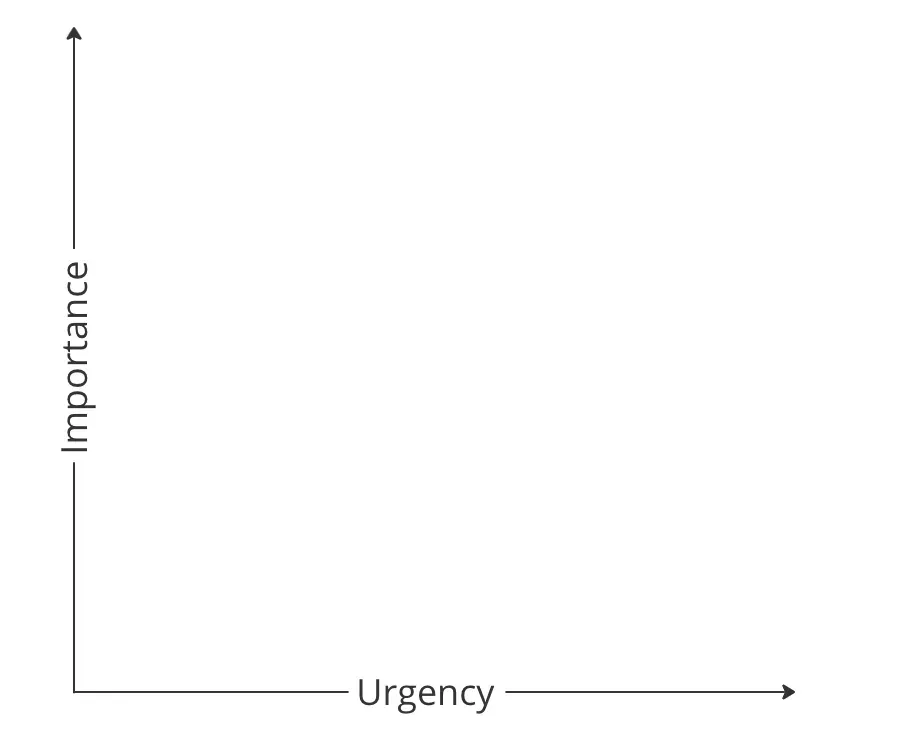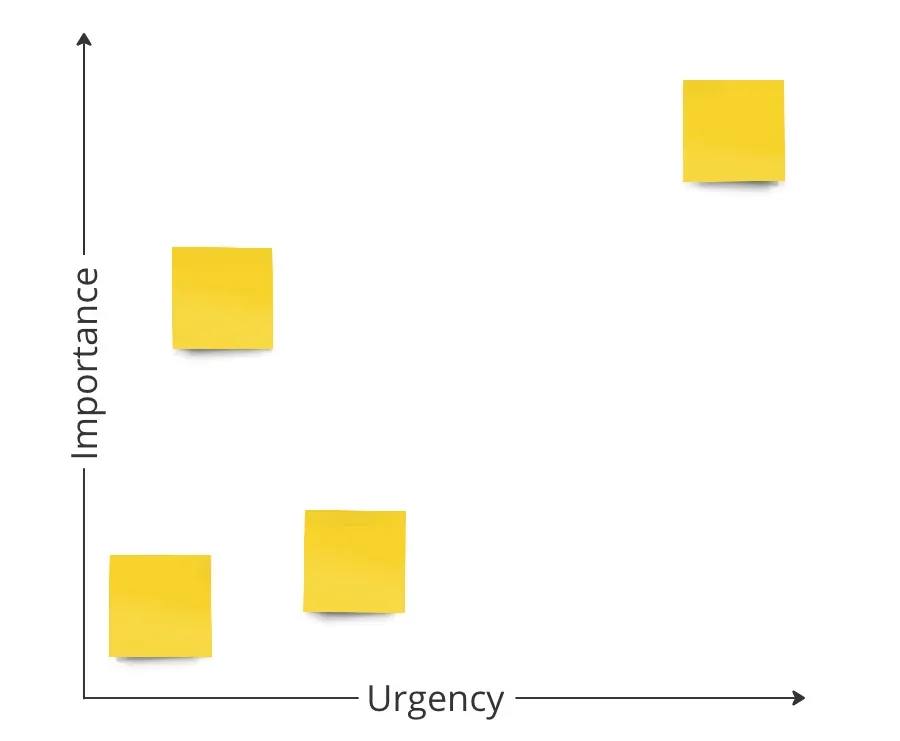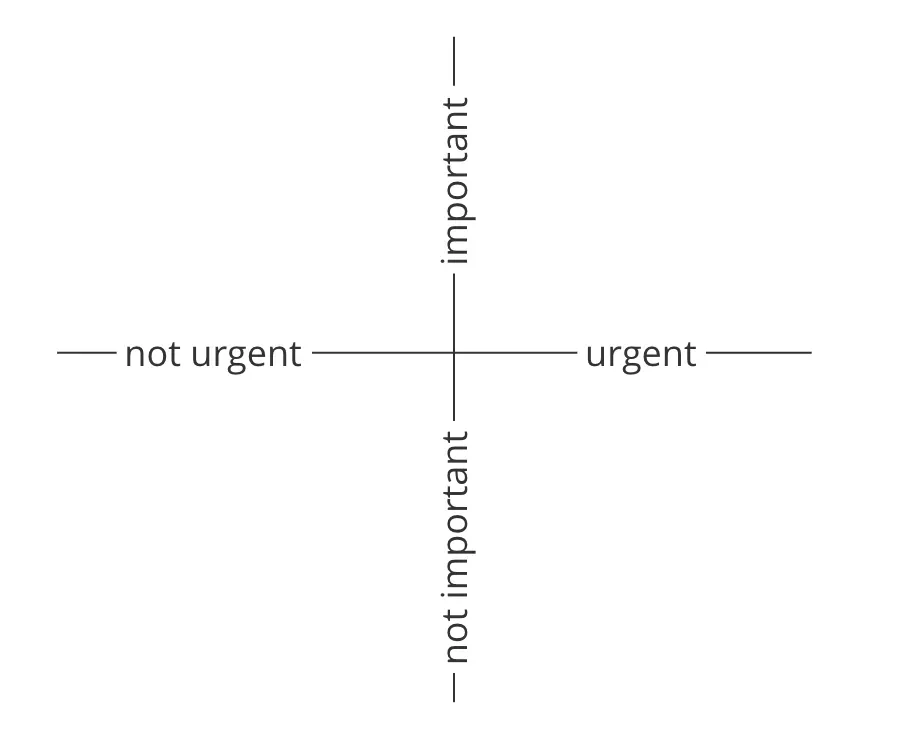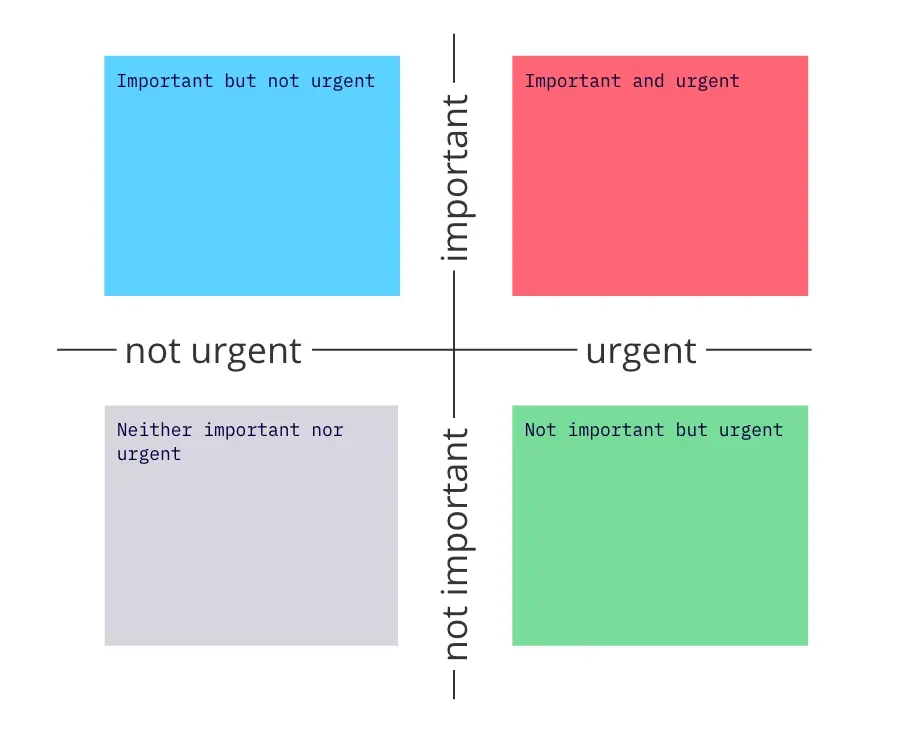Productive Creativity: A Guide to the Eisenhower Matrix
We're all constantly balancing different tasks, ideas and commitments in our lives. With each new day, we have to try to stay focused and productive while meeting our needs, personal goals, and demands from our clients. This can often leave us feeling overwhelmed and unsure of what to do next. Without realising it, the day slips away and we're left wondering what we've actually achieved.
In these circumstances, having a tool to structure our day becomes crucial if we don't want to burn out or fall into a procrastination trap. This is particularly true when we have many opportunities but limited time. With a good organisational tool, we can focus on our main goals without getting lost in less important tasks.
The tool I want to introduce today is the Eisenhower Matrix, based on a quote from U.S. President Dwight D. Eisenhower who said:
I have two kinds of problems, the urgent and the important. The urgent are not important, and the important are never urgent.[1]
The Eisenhower Matrix, which embodies this concept, enables us to rank our tasks according to their urgency and importance, leading to a more structured and productive day.
In this article I will show you what the Eisenhower Matrix looks like. You will learn how to interpret the four quadrants of the matrix and we will identify strategies that can help you apply this tool effectively in your daily life.
By understanding how to place your tasks within the matrix, you'll be able to focus on what's really important, manage your time more efficiently and ultimately improve your productivity.
We'll also discuss ways to manage distractions and prevent every task from becoming a 'fire' that needs to be put out immediately.
So whether you're a seasoned time management pro or just starting to get a handle on your daily tasks, this guide to the Eisenhower Matrix will provide valuable insights for everyone. Let's dive in!
Eisenhower Matrix 101
The Eisenhower Matrix operates within two key dimensions: Urgency and Importance.

In essence, we could immediately start using this framework to categorise our tasks. Each task can find its place in this space, ordered by its urgency and importance.

However, having a continuous space for positioning tasks can unintentionally complicate a system that's designed to simplify our lives. Questions like "Should I place this new task to the left or right of the other one?" or "Do I need to rearrange all my tasks to fit a new one?" can add unnecessary complexity and distract us from our actual goal.
To avoid this potential chaos, let's simplify things. Instead of plotting tasks on a continuous spectrum, let's sort tasks into defined categories: "Is this task important or not?" and "Is this task urgent or not?"

By implementing these clear categories, we arrive at the Eisenhower Matrix in its most useful form - a simple 2x2 grid with four quadrants:
- Quadrant 1: Important and urgent.
- Quadrant 2: Important but not urgent.
- Quadrant 3: Not important but urgent.
- Quadrant 4: Not important and not urgent.

Having a simple yet powerful tool at your fingertips can help everyone manage their time better and be more productive.
The Eisenhower Matrix is more than just a time management tool - it's also a stress management tool. By clearly defining what's urgent and what's important, you can prevent important tasks from becoming last-minute emergencies. You can prioritise tasks that contribute to your long-term goals, rather than just putting out fires. This, in turn, helps to reduce stress as you gain control of your workload, knowing that you're focusing on what really matters.
Of course, one of the key challenges for any creative using the Eisenhower Matrix will be deciding the urgency and importance of different tasks. This is often a fluid and complex task, where the decision depends heavily on the current context. But these three tools can help you in this decision-making process:
- Have clearly defined goals
Having well-defined, specific goals can help you judge whether a task is important based on whether it contributes to those goals. - Appreciate deadlines and stick to them.
Deadlines are clear indicators of urgency. A task due in the next hour is more urgent than one due next week. - Analyse possible consequences
Consider the consequences of not completing a task. The greater the negative impact, the more important and potentially urgent the task.
Exploring the Four Corners: How to Handle Tasks in Each Quadrant
Now that we know what the Eisenhower Matrix looks like and what thinking tools can help us prioritise our tasks, let's look at each quadrant in more detail.
Handling Quadrant 1: Navigating the Realm of 'Important & Urgent'
The first quadrant of the Eisenhower Matrix is the domain of tasks that are both important and urgent. For creatives, this might mean dealing with urgent client revisions, meeting impending project deadlines or delivering short-notice commissions. These are the tasks that require your immediate attention and action, and their completion often has a significant impact on your work.
Managing Quadrant 1 tasks efficiently is essential to avoid feeling overwhelmed and burnt out. There are a few strategies that can help you manage these tasks more smoothly:
- Consider time blocking: Set aside specific time slots during your day to focus on these critical tasks. Dedicated time can help you concentrate better and complete tasks efficiently.
- Use productivity tools: Use tools and applications that can help you manage your tasks. This could include project management software, digital calendars or even simple to-do list apps. They will help you keep track of deadlines and stay organised.
- Don't be afraid to ask for help: If a task is too big or outside your area of expertise, ask for help. Working with others can often speed up task completion and reduce your stress levels.
However, if you find that a large proportion of your tasks end up in this quadrant, it may be time to review your working practices. To avoid everything turning into a 'fire' that needs to be put out immediately, consider the following:
- Set Realistic Deadlines: When discussing project timelines with clients or collaborators, ensure the deadlines are achievable. Setting overly ambitious deadlines can frequently result in tasks becoming urgent before they need to be.
- Manage Client Expectations: Make sure your clients have a clear understanding of the time you require to deliver quality work. It's okay to push back respectfully on unreasonable timelines.
- Avoid Overcommitting: Learn to say no when your plate is full. Taking on more work than you can handle often leads to an overflow of Quadrant 1 tasks.
Navigating the realm of 'important and urgent' can be challenging, but with these strategies you'll be well equipped to keep your creative work on track and your stress levels in check.
Mastering Quadrant 2: The Heart of 'Important but Not Urgent'
The second quadrant is the realm of 'important but not urgent' and has a unique significance for creatives. This is where you'll find activities that don't have a deadline to meet, but that contribute significantly to your personal and professional growth. Quadrant 2 is where you hone your skills, build your portfolio, undertake personal projects and gather research and inspiration.
While these tasks are vital, their lack of immediate urgency can often mean that they get put off in favour of more pressing matters. Here are some techniques to ensure that Quadrant 2 tasks get the attention they deserve:
- Keep a regular schedule: Set aside time in your routine to work on these tasks. This could be a set hour each day, a specific day of the week, or even a weekend each month. The key is consistency.
- Set personal deadlines: Even if these tasks aren't bound by external deadlines, setting your own can create a sense of urgency and keep you motivated.
- Build habits: Make working on Quadrant 2 tasks a habit. For example, make it a habit to spend a few minutes each day practising a new skill, or set aside some time each week to update your portfolio.
Neglecting Quadrant 2 tasks may not have immediate consequences, but in the long run it could lead to missed opportunities for growth and improvement. If you find yourself consistently putting these tasks aside, it may be time to reassess.
Consider the long-term impact of these tasks on your career and personal growth. Remember that these activities are investments in your future self. Use the techniques above to make them part of your routine.
Mastering this quadrant is often what separates successful creatives from the rest. It's about playing the long game and recognising the value of continuous improvement and growth.
Dealing with Quadrant 3: The Deceptive 'Urgent but Not Important'
Navigating Quadrant 3 of the Eisenhower Matrix can be tricky, especially in a creative context. This quadrant is home to 'urgent but not important' tasks. They can appear as unscheduled meetings, responding to non-urgent emails or dealing with constant social media notifications. Although they seem to require immediate attention, they usually don't contribute to your fundamental goals or artistic development.
Successfully managing these tasks is about striking a careful balance. Here are some tips to keep them from taking over your schedule:
- Set boundaries: Inform your colleagues or clients of your availability for meetings or calls. Setting boundaries can help prevent unplanned interruptions during your most productive times.
- Use Do Not Disturb features: Use the features on your devices to minimise distractions. Activating 'Do Not Disturb' modes during your key focus times can work wonders.
- Delegate or outsource tasks: If you find that certain tasks aren't the best use of your time but still need to be done, consider delegating or even outsourcing them. For example, tasks such as managing social media accounts, writing copy or dealing with administrative tasks can often be handed over to a virtual assistant, copywriter, or consultant. This will free up your time to focus on tasks that are more integral to your personal growth and creativity.
By reducing the time, you spend on Quadrant 3 tasks, you can significantly increase your productivity and reduce your stress levels. It frees up time and mental energy to invest in more meaningful work - the important tasks that directly align with your goals and allow your creativity to flourish.
Remember, not all that glitters is gold, and urgency does not always indicate importance. With careful management, clear boundaries and strategic delegation or outsourcing, you can prevent these Quadrant 3 tasks from dominating your day and ensure that your focus remains where it really matters.
Navigating Quadrant 4: The Trivial 'Not Urgent & Not Important'
Quadrant 4 in the Eisenhower Matrix is the territory of the 'not urgent and not important' tasks. For creatives, these tasks might include excessive social media browsing, unnecessary perfectionism, or excessive research without application. These activities tend to be time-wasters, activities that consume your time and energy without contributing to your personal or professional growth.
However, it's important to remember that we're all human. A certain amount of downtime or less productive activities can serve as a mental break and shouldn't be eliminated altogether. The key is to strike a balance and be aware of when these activities start to interfere with your more important tasks.
One strategy to minimise these time-wasters is to set clear boundaries for yourself. Set aside a certain amount of time for these activities and stick to it. When the time is up, shift your focus to higher priority tasks. That way, you can still enjoy your downtime without letting it interfere with your productivity.
Conclusion
We've covered a lot of ground, from understanding the four quadrants of the Eisenhower Matrix to applying it specifically in a creative context. Prioritising can sometimes feel like a struggle for artists, with the line between work and passion often blurred. The Eisenhower Matrix provides a structure that can help manage this, separating the 'urgent' from the 'important' and the 'trivial' from the 'essential'.
However, like any tool, the Eisenhower Matrix is only as effective as the person using it. It's meant to be adapted and adjusted to suit your personal creative rhythms and working styles. Remember, it's not about rigidly categorising every task, but about raising an awareness of where your time and energy is going.
By consistently using and adapting the Eisenhower Matrix, you can free up time and mental space for your creativity to truly flourish. It's about working smarter, not harder, and ensuring that your energy is focused on the tasks that really matter to you. After all, in the creative world, time isn't just money—it's art, it's expression, it's a piece of your soul. So let's make it count.
- Dwight D. Eisenhower (August 19, 1954). Address at the Second Assembly of the World Council of Churches. Archived from the original on 2015-04-02. "Evanston, Illinois." ↩︎

